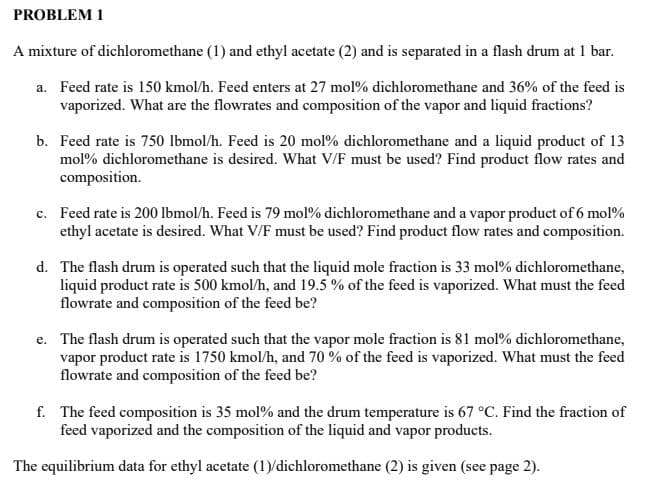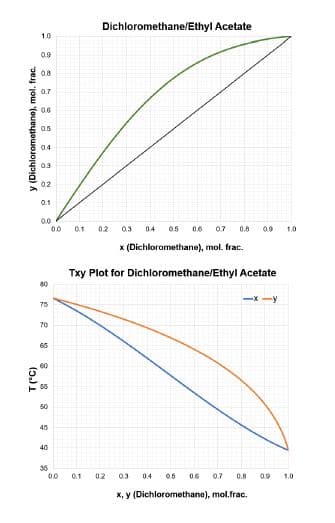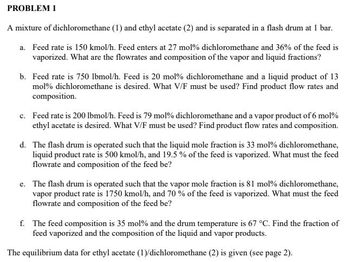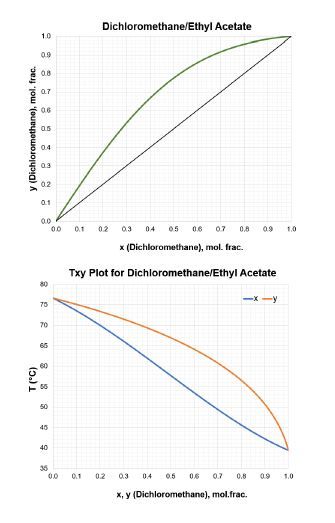PROBLEM 1 A mixture of dichloromethane (1) and ethyl acetate (2) and is separated in a flash drum at 1 bar. a. Feed rate is 150 kmol/h. Feed enters at 27 mol % dichloromethane and 36% of the feed is vaporized. What are the flowrates and composition of the vapor and liquid fractions? b. Feed rate is 750 lbmol/h. Feed is 20 mol % dichloromethane and a liquid product of 13 mol% dichloromethane is desired. What V/F must be used? Find product flow rates and composition. c. Feed rate is 200 lbmol/h. Feed is 79 mol % dichloromethane and a vapor product of 6 mol% ethyl acetate is desired. What V/F must be used? Find product flow rates and composition.
PROBLEM 1 A mixture of dichloromethane (1) and ethyl acetate (2) and is separated in a flash drum at 1 bar. a. Feed rate is 150 kmol/h. Feed enters at 27 mol % dichloromethane and 36% of the feed is vaporized. What are the flowrates and composition of the vapor and liquid fractions? b. Feed rate is 750 lbmol/h. Feed is 20 mol % dichloromethane and a liquid product of 13 mol% dichloromethane is desired. What V/F must be used? Find product flow rates and composition. c. Feed rate is 200 lbmol/h. Feed is 79 mol % dichloromethane and a vapor product of 6 mol% ethyl acetate is desired. What V/F must be used? Find product flow rates and composition.
Introduction to Chemical Engineering Thermodynamics
8th Edition
ISBN:9781259696527
Author:J.M. Smith Termodinamica en ingenieria quimica, Hendrick C Van Ness, Michael Abbott, Mark Swihart
Publisher:J.M. Smith Termodinamica en ingenieria quimica, Hendrick C Van Ness, Michael Abbott, Mark Swihart
Chapter1: Introduction
Section: Chapter Questions
Problem 1.1P
Related questions
Question
please help me out

Transcribed Image Text:PROBLEM 1
A mixture of dichloromethane (1) and ethyl acetate (2) and is separated in a flash drum at 1 bar.
a. Feed rate is 150 kmol/h. Feed enters at 27 mol % dichloromethane and 36% of the feed is
vaporized. What are the flowrates and composition of the vapor and liquid fractions?
b. Feed rate is 750 lbmol/h. Feed is 20 mol% dichloromethane and a liquid product of 13
mol% dichloromethane is desired. What V/F must be used? Find product flow rates and
composition.
c. Feed rate is 200 lbmol/h. Feed is 79 mol% dichloromethane and a vapor product of 6 mol %
ethyl acetate is desired. What V/F must be used? Find product flow rates and composition.
d. The flash drum is operated such that the liquid mole fraction is 33 mol % dichloromethane,
liquid product rate is 500 kmol/h, and 19.5% of the feed is vaporized. What must the feed
flowrate and composition of the feed be?
e. The flash drum is operated such that the vapor mole fraction is 81 mol % dichloromethane,
vapor product rate is 1750 kmol/h, and 70 % of the feed is vaporized. What must the feed
flowrate and composition of the feed be?
f. The feed composition is 35 mol % and the drum temperature is 67 °C. Find the fraction of
feed vaporized and the composition of the liquid and vapor products.
The equilibrium data for ethyl acetate (1)/dichloromethane (2) is given (see page 2).

Transcribed Image Text:y (Dichloromethane), mol. frac.
T (°C)
1.0
09
0.8
0.7
0.6
0.5
04
02
0.1
0.0
75
70
66
60
56
50
45
40
35
00
0.0
Dichloromethane/Ethyl Acetate
0.1 0.2 0.3 04 05
0.1
07 0.8
0.9 1.0
x (Dichloromethane), mol. frac.
Txy Plot for Dichloromethane/Ethyl Acetate
-x-y
0.2 0.3 0.4 0.5 06 0.7 0.8 0.9 1.0
x, y (Dichloromethane), mol.frac.
Expert Solution
This question has been solved!
Explore an expertly crafted, step-by-step solution for a thorough understanding of key concepts.
Step by step
Solved in 5 steps

Follow-up Questions
Read through expert solutions to related follow-up questions below.
Follow-up Question
please answer d-f ,please.

Transcribed Image Text:PROBLEM 1
A mixture of dichloromethane (1) and ethyl acetate (2) and is separated in a flash drum at 1 bar.
a. Feed rate is 150 kmol/h. Feed enters at 27 mol % dichloromethane and 36% of the feed is
vaporized. What are the flowrates and composition of the vapor and liquid fractions?
b. Feed rate is 750 lbmol/h. Feed is 20 mol% dichloromethane and a liquid product of 13
mol% dichloromethane is desired. What V/F must be used? Find product flow rates and
composition.
c. Feed rate is 200 lbmol/h. Feed is 79 mol% dichloromethane and a vapor product of 6 mol %
ethyl acetate is desired. What V/F must be used? Find product flow rates and composition.
d. The flash drum is operated such that the liquid mole fraction is 33 mol % dichloromethane,
liquid product rate is 500 kmol/h, and 19.5% of the feed is vaporized. What must the feed
flowrate and composition of the feed be?
e. The flash drum is operated such that the vapor mole fraction is 81 mol % dichloromethane,
vapor product rate is 1750 kmol/h, and 70 % of the feed is vaporized. What must the feed
flowrate and composition of the feed be?
f. The feed composition is 35 mol % and the drum temperature is 67 °C. Find the fraction of
feed vaporized and the composition of the liquid and vapor products.
The equilibrium data for ethyl acetate (1)/dichloromethane (2) is given (see page 2).

Transcribed Image Text:y (Dichloromethane), mol. frac.
T (°C)
1.0
09
0.8
0.7
0.6
0.5
04
02
0.1
0.0
75
70
66
60
56
50
45
40
35
00
0.0
Dichloromethane/Ethyl Acetate
0.1 0.2 0.3 04 05
0.1
07 0.8
0.9 1.0
x (Dichloromethane), mol. frac.
Txy Plot for Dichloromethane/Ethyl Acetate
-x-y
0.2 0.3 0.4 0.5 06 0.7 0.8 0.9 1.0
x, y (Dichloromethane), mol.frac.
Solution
Recommended textbooks for you

Introduction to Chemical Engineering Thermodynami…
Chemical Engineering
ISBN:
9781259696527
Author:
J.M. Smith Termodinamica en ingenieria quimica, Hendrick C Van Ness, Michael Abbott, Mark Swihart
Publisher:
McGraw-Hill Education

Elementary Principles of Chemical Processes, Bind…
Chemical Engineering
ISBN:
9781118431221
Author:
Richard M. Felder, Ronald W. Rousseau, Lisa G. Bullard
Publisher:
WILEY

Elements of Chemical Reaction Engineering (5th Ed…
Chemical Engineering
ISBN:
9780133887518
Author:
H. Scott Fogler
Publisher:
Prentice Hall

Introduction to Chemical Engineering Thermodynami…
Chemical Engineering
ISBN:
9781259696527
Author:
J.M. Smith Termodinamica en ingenieria quimica, Hendrick C Van Ness, Michael Abbott, Mark Swihart
Publisher:
McGraw-Hill Education

Elementary Principles of Chemical Processes, Bind…
Chemical Engineering
ISBN:
9781118431221
Author:
Richard M. Felder, Ronald W. Rousseau, Lisa G. Bullard
Publisher:
WILEY

Elements of Chemical Reaction Engineering (5th Ed…
Chemical Engineering
ISBN:
9780133887518
Author:
H. Scott Fogler
Publisher:
Prentice Hall


Industrial Plastics: Theory and Applications
Chemical Engineering
ISBN:
9781285061238
Author:
Lokensgard, Erik
Publisher:
Delmar Cengage Learning

Unit Operations of Chemical Engineering
Chemical Engineering
ISBN:
9780072848236
Author:
Warren McCabe, Julian C. Smith, Peter Harriott
Publisher:
McGraw-Hill Companies, The